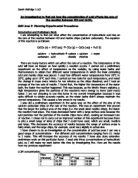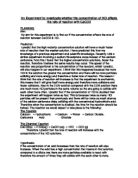Temperature
The higher the temperature the more energy each particle will have which means it will vibrate more, causing the amount of collisions to increase. As the particles collide more than usual at a high temperature then it will have a high chance of reacting, this will increase the rate of reaction. Below is a graph of how temperature and the rate of the reaction are related:
Activation Energy
Activation Energy is an amount of Energy needed for a reaction to occur, this amount varies from different elements and type of reaction. This may save energy for industrial use, as they will only supply the amount of energy needed exactly and not more.
The Collision Theory
From the kinetic theory of gases, the collision theory of bimolecular reactions in a gas phase was developed. In a reaction between two gaseous substances A&B a molecule of A must collide with B for the reaction to proceed but in a concentrated solution there will be a higher percent of reactants which will have no more energy. Not all collisions cause a reaction, only the ones which reach the activation energy of the reaction. This is why I predict that the rate of reaction will increase as the concentration of a solution increases.
Apparatus factor (1):
? Syringe (gas collector)
? Conical flask
? Marble chips (CaCO3) powder
? Acid (HCl)
? Measuring cylinder(5 ml)
? Glass tube
? Clock
? Clamp
? Top man balance
? Cork
? Glass tube
Method factor (1):
First, I prepared the apparatus above, I found that the apparatus is good enough to carry out the experiment and get reliable results. First, I will use the top man balance to weigh out 1g of CaCO3, which is in powder form. Make sure the apparatus is safe and then you will be able to measure out the amount of acid decided on, and add it to the conical flask. Also, after measuring the CaCO3 you would be able add that to the conical flask. To keep the experiment fair you need to always place the acid first then the Calcium Carbonate or the opposite, this must be done all the time. As you add both reactants to a conical flask, you must immediately place the cork onto the flask. There is also the syringe were the gas is collected and connected to a glass tube and the cork, the gas collected would be CO2. The range for the concentration of the acid I would use is 10,8,6,4,2cm3 and 0,2,4,6,8cm3 of the water added to the acid.
I will not use 0cm3 of acid with 10cm3 of water because there will be no reaction. To keep the experiment fair I kept the temperature of the solution constant at room temperature as well as the particle size of the Calcium Carbonate. You also had to make sure that the amount of CaCO3 must be kept constant so I used 1g. In addition, I used a clock to measure the time taken from as soon as the reactants are put together.
Type of Variable Variable
Control Temperature, chip size, chip mass
Dependant Concentration of acid
Independent Time
Results factor (1):
Concentration: 10ml acid 0 water
Time 15 30 45 60
Vol. of gas 1st 34 53 73 81
Vol. of gas 2nd 33 50 60 68
Concentration: 8ml acid 2 water
Time 15 30 45 60
Vol. of gas 1st 27 42 55 62
Vol. of gas 2nd 25 45 60 71
Concentration: 6ml acid 4 water
Time 15 30 45 60
Vol. of gas 1st 22 40 50 58
Vol. of gas 2nd 21 34 43 57
Concentration: 4ml acid 6 water
Time 15 30 45 60
Vol. of gas 1st 10 18 25 31
Vol. of gas 2nd 14 25 32 38
Concentration: 2ml acid 8 water
Time 15 30 45 60
Vol. of gas 1st 0 3 5 7
Vol. of gas 2nd 4 7 9 10
Concentration: 0ml acid 10 water
Time 15 30 45 60
Vol. of gas 1st
Vol. of gas 2nd
Did not do experiment would take to long
Concentration of acid 2mol
Temperature: Constant at Room Temperature
Chip size: Constant Powder
Chip mass: Constant at 1g
Below is the graph for the results:
Conclusion factor (1):
My conclusion is that the experiment was successful and that the results were reliable to make a conclusion from, we also find that the results were like my prediction and like the preliminary test. I also will conclude that concentration of the acid does effect the rate of reaction.
There were a couple of points for the experiment to be improved by, first that by adding the CaCO3 and quickly placing the cork on top will lose time and some of the immediate product is lost. Also that a normal person pressing the time is not the most accurate of techniques. This obviously increases the error percentage in the results making the result outcome slightly incorrect. One way to improve the experiment would be to use a cork with two holes fitted with valves. One to enter the acid and CaCO3 powder and one connected to the syringe for the product of the reactants to be let out. In my view, I find this a more reliable technique.
In addition, from the graphs I concluded that after the reaction reaches a peak it slowly comes to a complete halt. This meant that the graph was accelerating at first and then the gradient changed for the curve to become towards a vertical line.
Evaluation factor (1):
I evaluate that the experiment was successful and got reliable results. Although there was space for improvement the resources available for the experiment was limited, therefore I was not able to use sophisticated devices.
During the whole experiment, it has always been a fair test, which helped in getting good results.
Aim factor (2):
My aim for this experiment is to find out if the temperature effects the rate of reaction between CaCO3 & HCl.
Prediction factor (2):
My prediction is that if the temperature increases than the rate of reaction will increase. This is because when the temperature increases the energy of the particle increase therefore making it more liable to react as they will collide with the reactants much faster.
In addition, when the amount of energy will increase the vibrations of the particles increase.
In addition, we had done a preliminary experiment, which proved that when the temperature was almost 60°C the reaction was immediate, when the temperature was at room temperature. Form this I can make a prediction of that the higher the temperature the faster the rate of reaction.
Hypothesis factor (2):
For the hypothesis In say that when the temperature increases there is more vibration from the particles which would, make more collisions with the reactant which will increase the rate of reaction.
Also as the reactants are not living organism there is no real limit on the temperature raised to, as no cells will be denatured.
Apparatus factor (2):
? Syringe (gas collector)
? Conical flask
? Marble chips (CaCO3) powder
? Acid (HCl)
? Measuring cylinder(5 ml)
? Glass tube
? Clock
? Clamp
? Top man balance
? Cork
? Bunsen burner.
? Tripod
? Gauze
? Safety mat.
Method factor (2):
First, I prepared the apparatus above, I found that the apparatus is good enough to carry out the experiment and get reliable results. I will use the top man balance to weigh out 1g of CaCO3, which is in powder form this amount will be used throughout the experiment. Also, make sure the apparatus is safe and then you will be able to heat the acid to the decided temperature. The temperature heated up to should not exceed around 60°C because of the acid is dangerous at a higher temperature. Then the heated solution would be added to the conical flask, also after measuring the CaCO3 you would be able to add that to the conical flask. To keep the experiment fair you need to always place the acid first then the Calcium Carbonate or the opposite, this must be done all the time. As you add both reactants to a conical flask, you must immediately place the cork onto the flask. There is also the syringe were the gas is collected and connected to a glass tube and the cork, the gas collected would be CO2. The range of temperature would be used is 0,10,20,30,40,50,60°C as this range is a safe range and enough to receive a reliable result.
The experiment will last 1 minute after that the volume of gas will be taken and that will be the result.
To keep the experiment fair I used the same concentration of acid all the time and the same surface area of the Calcium Carbonate. You also had to make sure that the amount of CaCO3 must be kept constant so I used 1g throughout the experiment. In addition, I used a clock to measure the time taken from as soon as the reactants are put together.
Type of Variable Variable
Control Concentration, chip size, chip mass
Dependant Temperature of acid
Independent Time
Results factor (2):
Temperature: 0°C
Temperature (°C) Vol. of gas 1st (cm3) Vol. of gas 2nd(cm3) Average volume of gas
0
Did not do experiment would take to long.
Temperature: 10°C
Temperature (°C) Vol. of gas 1st (cm3) Vol. of gas 2nd(cm3) Average volume of gas
10 28 29 28.5
Temperature: 20°C
Temperature (°C) Vol. of gas 1st (cm3) Vol. of gas 2nd(cm3) Average volume of gas
20 33 37 35
Temperature: 30°C
Temperature (°C) Vol. of gas 1st (cm3) Vol. of gas 2nd(cm3) Average volume of gas
30 39 46 42.5
Temperature: 40°C
Temperature (°C) Vol. of gas 1st (cm3) Vol. of gas 2nd(cm3) Average volume of gas
40 53 56 54.5
Temperature: 50°C
Temperature (°C) Vol. of gas 1st (cm3) Vol. of gas 2nd(cm3) Average volume of gas
50 71 62 66.5
Temperature: 60°C
Temperature (°C) Vol. of gas 1st (cm3) Vol. of gas 2nd(cm3) Average volume of gas
60 74 79 76.5
Concentration: Constant (2 mol/dm3)
Surface area of CaCO3: Constant (powder)
Below is the graph for the results:
Conclusion factor (2):
I conclude from the experiment that the temperature will effect the rate of the reaction between HCl and CaCO3. This is because when the temperature was raised the particles will vibrate more making them react faster because the amount of collisions will be higher and faster. There fore I will conclude that the temperature is a factor because looking at the graph we can see that there is a gradient change, which means that there, is a change in the rate of reaction.
Also I see that the results were reliable and it was successfully carried out as the results showed that there is a change in the volume of the gas collected.
Evaluation factor (2):
I must say that the experiment was a fair test but not very accurate. The results could have been more accurate and more reliable if I was able to use the computer and sophisticated equipment to take the results such as a temperature detector. If I was able to use them then I will get much more reliable results and the percentage error will be very insignificant.
Overall this was a well-taken experiment with the results needed and the prediction coming out correctly







